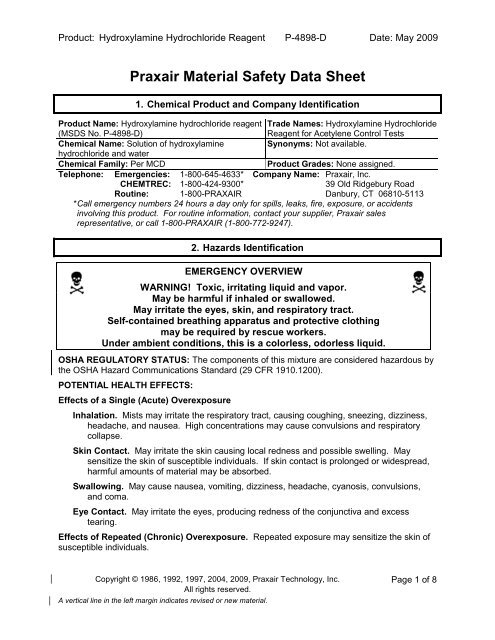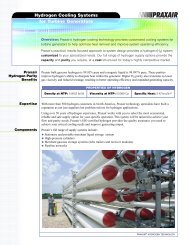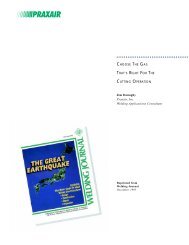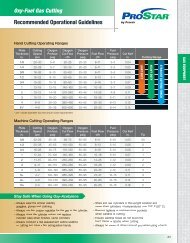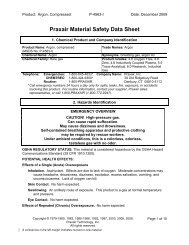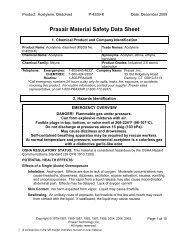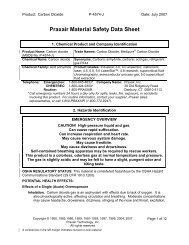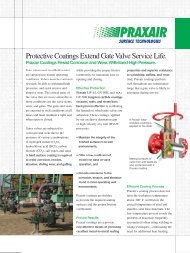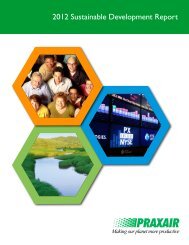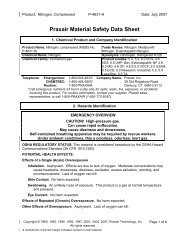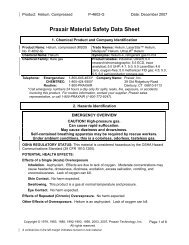Hydroxylamine Hydrochloride Reagent - Praxair
Hydroxylamine Hydrochloride Reagent - Praxair
Hydroxylamine Hydrochloride Reagent - Praxair
Create successful ePaper yourself
Turn your PDF publications into a flip-book with our unique Google optimized e-Paper software.
Product: <strong>Hydroxylamine</strong> <strong>Hydrochloride</strong> <strong>Reagent</strong> P-4898-D Date: May 2009<br />
<strong>Praxair</strong> Material Safety Data Sheet<br />
1. Chemical Product and Company Identification<br />
Product Name: <strong>Hydroxylamine</strong> hydrochloride reagent Trade Names: <strong>Hydroxylamine</strong> <strong>Hydrochloride</strong><br />
(MSDS No. P-4898-D)<br />
<strong>Reagent</strong> for Acetylene Control Tests<br />
Chemical Name: Solution of hydroxylamine<br />
hydrochloride and water<br />
Synonyms: Not available.<br />
Chemical Family: Per MCD Product Grades: None assigned.<br />
Telephone: Emergencies: 1-800-645-4633* Company Name: <strong>Praxair</strong>, Inc.<br />
CHEMTREC: 1-800-424-9300* 39 Old Ridgebury Road<br />
Routine: 1-800-PRAXAIR Danbury, CT 06810-5113<br />
* Call emergency numbers 24 hours a day only for spills, leaks, fire, exposure, or accidents<br />
involving this product. For routine information, contact your supplier, <strong>Praxair</strong> sales<br />
representative, or call 1-800-PRAXAIR (1-800-772-9247).<br />
2. Hazards Identification<br />
EMERGENCY OVERVIEW<br />
WARNING! Toxic, irritating liquid and vapor.<br />
May be harmful if inhaled or swallowed.<br />
May irritate the eyes, skin, and respiratory tract.<br />
Self-contained breathing apparatus and protective clothing<br />
may be required by rescue workers.<br />
Under ambient conditions, this is a colorless, odorless liquid.<br />
OSHA REGULATORY STATUS: The components of this mixture are considered hazardous by<br />
the OSHA Hazard Communications Standard (29 CFR 1910.1200).<br />
POTENTIAL HEALTH EFFECTS:<br />
Effects of a Single (Acute) Overexposure<br />
Inhalation. Mists may irritate the respiratory tract, causing coughing, sneezing, dizziness,<br />
headache, and nausea. High concentrations may cause convulsions and respiratory<br />
collapse.<br />
Skin Contact. May irritate the skin causing local redness and possible swelling. May<br />
sensitize the skin of susceptible individuals. If skin contact is prolonged or widespread,<br />
harmful amounts of material may be absorbed.<br />
Swallowing. May cause nausea, vomiting, dizziness, headache, cyanosis, convulsions,<br />
and coma.<br />
Eye Contact. May irritate the eyes, producing redness of the conjunctiva and excess<br />
tearing.<br />
Effects of Repeated (Chronic) Overexposure. Repeated exposure may sensitize the skin of<br />
susceptible individuals.<br />
Copyright © 1986, 1992, 1997, 2004, 2009, <strong>Praxair</strong> Technology, Inc. Page 1 of 8<br />
All rights reserved.<br />
A vertical line in the left margin indicates revised or new material.
Product: <strong>Hydroxylamine</strong> <strong>Hydrochloride</strong> <strong>Reagent</strong> P-4898-D Date: May 2009<br />
Other Effects of Overexposure. None known.<br />
Medical Conditions Aggravated by Overexposure. The irritating properties of this material<br />
may aggravate an existing dermatitis. Breathing mists may aggravate asthma and inflammatory<br />
or fibrotic pulmonary disease.<br />
CARCINOGENICITY: None of the components of this material is listed by NTP, OSHA, or<br />
IARC.<br />
POTENTIAL ENVIRONMENTAL EFFECTS: None known. For further information, see section<br />
12, Ecological Information.<br />
3. Composition/Information on Ingredients<br />
COMPONENT CAS NUMBER CONCENTRATION<br />
<strong>Hydroxylamine</strong> hydrochloride 5470-11-1 36%*<br />
Water 7732-18-5 64%*<br />
**Percentages are approximate<br />
4. First Aid Measures<br />
INHALATION: Remove to fresh air. If not breathing, give artificial respiration. If breathing is<br />
difficult, qualified personnel may give oxygen. Call a physician.<br />
SKIN CONTACT: Remove contaminated clothing and shoes and wash skin with plenty of soap<br />
and water. Wash clothing before reuse. If irritation persists or if contact was prolonged, call a<br />
physician.<br />
SWALLOWING: If victim is conscious and alert, give at least two glasses of milk or water and<br />
induce vomiting. Never give anything by mouth to an unconscious, convulsive, or unresponsive<br />
person. Call a physician.<br />
EYE CONTACT: Immediately flush eyes thoroughly with plenty of water and continue for at<br />
least 15 minutes. Hold the eyelids open and away from the eyeballs to ensure that all surfaces<br />
are flushed thoroughly. See a physician, preferably an ophthalmologist, immediately.<br />
NOTES TO PHYSICIAN: This material, depending on amount and duration of exposure, can<br />
cause high levels of methemoglobin. Treatment of overexposure should be directed at the<br />
control of symptoms and the clinical condition.<br />
NOTE: This liquid is used in equipment to determine the purity of gaseous acetylene. Users<br />
must be familiar with the operations and hazards associated with the equipment.<br />
Contact the Poison Control Center in your area for additional information on patient<br />
management and follow-up.<br />
5. Fire Fighting Measures<br />
FLAMMABLE PROPERTIES: <strong>Hydroxylamine</strong> hydrochloride reagent cannot catch fire<br />
SUITABLE EXTINGUISHING MEDIA: Use media appropriate for surrounding fire.<br />
PRODUCTS OF COMBUSTION: Not applicable. Products of thermal decomposition include<br />
sulfur oxides, ammonia, and/or nitrogen oxides. (See section 10.)<br />
Page 2 of 8
Product: <strong>Hydroxylamine</strong> <strong>Hydrochloride</strong> <strong>Reagent</strong> P-4898-D Date: May 2009<br />
PROTECTION OF FIREFIGHTERS: WARNING! Toxic, irritating liquid and vapor. Evacuate<br />
all personnel from danger area. Wear self-contained breathing apparatus where needed.<br />
Immediately deluge containers with water spray from maximum distance until cool; then move<br />
them away from fire area if without risk. On-site fire brigades must comply with OSHA 29 CFR<br />
1910.156.<br />
Specific Physical and Chemical Hazards. Heat of fire may build pressure in container,<br />
causing rupture. No part of a container should be subjected to temperatures above 125°F<br />
(52°C).<br />
Protective Equipment and Precautions for Firefighters. Firefighters should wear selfcontained<br />
breathing apparatus and full fire-fighting turnout gear.<br />
6. Accidental Release Measures<br />
STEPS TO BE TAKEN IF MATERIAL IS RELEASED OR SPILLED:<br />
WARNING! Toxic, irritating liquid and vapor.<br />
Personal Precautions. Do not get on skin, in eyes, or on clothing. Keep personnel away.<br />
Wear self-contained breathing apparatus where needed. Use solid absorbent to pick up spilled<br />
material. Ventilate area of spill, or move leaking container to a well-ventilated area. Prevent<br />
runoff from contaminating surrounding environment.<br />
Environmental Precautions. Prevent waste from contaminating the surrounding environment.<br />
Keep personnel away. Discard any product, residue, disposable container, or liner in an<br />
environmentally acceptable manner, in full compliance with federal, state, and local regulations.<br />
If necessary, call your local supplier for assistance.<br />
7. Handling and Storage<br />
PRECAUTIONS TO BE TAKEN IN HANDLING: Do not get liquid or vapor in eyes, on skin, or<br />
on clothing. Have safety showers and eyewash fountains immediately available to exposed<br />
workers. Wash thoroughly after handling. Protect containers against physical damage. Wash<br />
thoroughly after handling.<br />
PRECAUTIONS TO BE TAKEN IN STORAGE: Store in a cool, dry, well-ventilated area. Keep<br />
container closed when not in use and when empty.<br />
8. Exposure Controls/Personal Protection<br />
COMPONENT OSHA PEL ACGIH TLV-TWA (2008)<br />
<strong>Hydroxylamine</strong> hydrochloride Not Established. Not Established.<br />
Water Not Established. Not Established.<br />
IDLH = Not available.<br />
ENGINEERING CONTROLS:<br />
Local Exhaust. Use local exhaust ventilation with sufficient air flow velocity to keep vapor<br />
concentrations low.<br />
Mechanical (General). May be acceptable under certain conditions if sufficient to keep vapor<br />
concentrations low.<br />
Special. None<br />
Page 3 of 8
Product: <strong>Hydroxylamine</strong> <strong>Hydrochloride</strong> <strong>Reagent</strong> P-4898-D Date: May 2009<br />
Other. None<br />
PERSONAL PROTECTIVE EQUIPMENT:<br />
Skin Protection. Wear butyl rubber gloves. Select in accordance with OSHA 29 CFR<br />
1910.132. Protective clothing where needed. Select in accordance with OSHA 29 CFR<br />
1910.132 and 1910.133. Regardless of protective equipment, never touch live electrical parts.<br />
Eye/Face Protection. Select in accordance with OSHA 29 CFR 1910.133.<br />
Respiratory Protection. A respiratory protection program that meet OSHA 29 CFR 1910.134,<br />
ANSI Z88.2, or MSHA 30 CFR 72.710 (where applicable) requirements must be followed<br />
whenever workplace conditions warrant respirator use. Use an air-supplied or air-purifying<br />
cartridge if the action level is exceeded. Ensure the respirator has the appropriate protection<br />
factor for the exposure level. If cartridge type respirators are used, the cartridge must be<br />
appropriate for the chemical exposure (e.g., an organic vapor cartridge). For emergencies or<br />
instances with unknown exposure levels, use a self-contained breathing apparatus.<br />
9. Physical and Chemical Properties<br />
APPEARANCE: Clear, colorless liquid<br />
ODOR: Odorless<br />
ODOR THRESHOLD: Not available.<br />
PHYSICAL STATE: Liquid at normal temperature and pressure<br />
pH: 2.0<br />
FREEZING POINT at 1 atm: 14.7°F (-9.6°C)<br />
BOILING POINT at 1 atm: 216.9°F (102.7°C) (calculated)<br />
FLASH POINT (test method): Not applicable.<br />
EVAPORATION RATE (Butyl Acetate = 1): Low<br />
FLAMMABILITY: Nonflammable<br />
FLAMMABLE LIMITS IN AIR, % by volume: LOWER: Not<br />
applicable.<br />
UPPER: Not<br />
applicable.<br />
VAPOR PRESSURE at 68°F (20°C) at 1 atm: 0.3392 psig (17.54 mm Hg) (estimated)<br />
VAPOR DENSITY at 70°F (21.1°C) and 1 atm: Not available.<br />
SPECIFIC GRAVITY (H2O = 1) at 68°F (20°C): 1.36 (calculated)<br />
SPECIFIC GRAVITY (Air = 1) at 68°F (20°C) and<br />
1 atm:<br />
0.014<br />
SOLUBILITY IN WATER 68°F (20°C): 100%<br />
PARTITION COEFFICIENT: n-octanol/water: Not available.<br />
AUTOIGNITION TEMPERATURE: Not applicable.<br />
DECOMPOSITION TEMPERATURE: Not available.<br />
PERCENT VOLATILES BY VOLUME: >64%<br />
MOLECULAR WEIGHT: Not available.<br />
MOLECULAR FORMULA: Solution of ClH4NO & H2O<br />
Page 4 of 8
Product: <strong>Hydroxylamine</strong> <strong>Hydrochloride</strong> <strong>Reagent</strong> P-4898-D Date: May 2009<br />
10. Stability and Reactivity<br />
CHEMICAL STABILITY: Unstable Stable<br />
CONDITIONS TO AVOID: Heat. Solution is stable at normal temperatures and pressures.<br />
INCOMPATIBLE MATERIALS: Mixtures containing ethers and aldehydes. Mixtures containing<br />
pyridine and sodium acetate. Acids, alkalies, oxidizers, water reactive compounds such as<br />
alkali metals, metal hydrides, and/or complex hydrides.<br />
HAZARDOUS DECOMPOSITION PRODUCTS: Thermal decomposition may produce<br />
hydrogen chloride, ammonia, and/or nitrogen oxides.<br />
POSSIBILITY OF HAZARDOUS REACTIONS: May Occur Will Not Occur<br />
Thermal decomposition may produce hydrogen chloride, ammonia, and/or nitrogen oxides.<br />
11. Toxicological Information<br />
ACUTE DOSE EFFECTS: None known.<br />
STUDY RESULTS: Tests have shown this material to be mutagenic in a variety of in-vitro test<br />
systems.<br />
12. Ecological Information<br />
ECOTOXICITY: No known effects.<br />
OTHER ADVERSE EFFECTS: <strong>Hydroxylamine</strong> hydrochloride reagent does not contain any<br />
Class I or Class II ozone-depleting chemicals.<br />
13. Disposal Considerations<br />
WASTE DISPOSAL METHOD: Dispose of this product in an environmentally acceptable<br />
manner in full compliance with federal, state, and local regulations. Do not pour down drains,<br />
into sewers, or otherwise release into the environment. Place into lab packs for pickup by a<br />
licensed hazardous waste disposal service or use other authorized means. See section 6 for<br />
disposal following spills.<br />
DOT/IMO SHIPPING NAME: Not regulated.<br />
HAZARD<br />
CLASS:<br />
NA*<br />
PACKING<br />
GROUP/Zone:<br />
14. Transport Information<br />
NA*<br />
SHIPPING LABEL(s): NA*<br />
PLACARD (when required): NA*<br />
*NA-Not applicable.<br />
IDENTIFICATION<br />
NUMBER:<br />
NA*<br />
PRODUCT<br />
RQ:<br />
None<br />
MARINE POLLUTANTS: None of the components of this solution a listed as a marine pollutant<br />
by DOT.<br />
Page 5 of 8
Product: <strong>Hydroxylamine</strong> <strong>Hydrochloride</strong> <strong>Reagent</strong> P-4898-D Date: May 2009<br />
15. Regulatory Information<br />
The following selected regulatory requirements may apply to this product. Not all such<br />
requirements are identified. Users of this product are solely responsible for compliance with all<br />
applicable federal, state, and local regulations.<br />
U.S. FEDERAL REGULATIONS:<br />
EPA (ENVIRONMENTAL PROTECTION AGENCY)<br />
CERCLA: COMPREHENSIVE ENVIRONMENTAL RESPONSE, COMPENSATION,<br />
AND LIABILITY ACT OF 1980 (40 CFR Parts 117 and 302):<br />
Reportable Quantity (RQ): None<br />
SARA: SUPERFUND AMENDMENT AND REAUTHORIZATION ACT:<br />
SECTIONS 302/304: Require emergency planning based on Threshold Planning<br />
Quantity (TPQ) and release reporting based on Reportable Quantities (RQ) of<br />
Extremely Hazardous Substances (EHS) (40 CFR Part 355):<br />
TPQ: None<br />
EHS RQ (40 CFR 355): None<br />
SECTIONS 311/312: Require submission of MSDSs and reporting of chemical<br />
inventories with identification of EPA hazard categories. The hazard categories for<br />
this product are as follows:<br />
IMMEDIATE: Yes PRESSURE: No<br />
DELAYED: Yes REACTIVITY: No<br />
FIRE: No<br />
SECTION 313: Requires submission of annual reports of release of toxic chemicals<br />
that appear in 40 CFR Part 372.<br />
None of the components of this solution are subject to reporting under Section<br />
313.<br />
40 CFR 68: RISK MANAGEMENT PROGRAM FOR CHEMICAL ACCIDENTAL<br />
RELEASE PREVENTION: Requires development and implementation of risk<br />
management programs at facilities that manufacture, use, store, or otherwise handle<br />
regulated substances in quantities that exceed specified thresholds.<br />
None of the components of this solution are listed as regulated substances.<br />
TSCA: TOXIC SUBSTANCES CONTROL ACT: The components of this solution are<br />
listed on the TSCA inventory.<br />
OSHA: OCCUPATIONAL SAFETY AND HEALTH ADMINISTRATION:<br />
29 CFR 1910.119: PROCESS SAFETY MANAGEMENT OF HIGHLY HAZARDOUS<br />
CHEMICALS: Requires facilities to develop a process safety management program<br />
based on Threshold Quantities (TQ) of highly hazardous chemicals.<br />
None of the components of this solution are listed in Appendix A as highly hazardous<br />
chemicals.<br />
STATE REGULATIONS:<br />
CALIFORNIA: None of the components of this solution are listed by California under the<br />
SAFE DRINKING WATER AND TOXIC ENFORCEMENT ACT OF 1986 (Proposition 65).<br />
PENNSYLVANIA: The components of this solution are subject to the PENNSYLVANIA<br />
WORKER AND COMMUNITY RIGHT-TO-KNOW ACT (35 P.S. Sections 7301-7320).<br />
Page 6 of 8
Product: <strong>Hydroxylamine</strong> <strong>Hydrochloride</strong> <strong>Reagent</strong> P-4898-D Date: May 2009<br />
16. Other Information<br />
Be sure to read and understand all labels and instructions supplied with all containers of this<br />
product.<br />
OTHER HAZARDOUS CONDITIONS OF HANDLING, STORAGE, AND USE: Toxic, irritating<br />
liquid and vapor. Store and use with adequate ventilation at all times. Keep container<br />
closed when not in use, even when empty. Use piping and equipment compatible with the<br />
components of this solution.<br />
NOTE: Prior to using any plastics, confirm their compatibility with the components of this<br />
solution.<br />
MIXTURES: When you mix two or more chemicals, you can create additional, unexpected<br />
hazards. Obtain and evaluate the safety information for each component before you produce<br />
the mixture. Consult an industrial hygienist or other trained person when you evaluate the end<br />
product. Remember, solids, liquids, and vapors have properties that can cause serious injury or<br />
death.<br />
HAZARD RATING SYSTEMS:<br />
NFPA RATINGS: HMIS RATINGS:<br />
HEALTH = 2 HEALTH = 2<br />
FLAMMABILITY = 0 FLAMMABILITY = 0<br />
INSTABILITY = 0 PHYSICAL HAZARD = 0<br />
SPECIAL = None<br />
Page 7 of 8
Product: <strong>Hydroxylamine</strong> <strong>Hydrochloride</strong> <strong>Reagent</strong> P-4898-D Date: May 2009<br />
<strong>Praxair</strong> asks users of this product to study this MSDS and become aware of product hazards<br />
and safety information. To promote safe use of this product, a user should (1) notify employees,<br />
agents, and contractors of the information in this MSDS and of any other known product<br />
hazards and safety information, (2) furnish this information to each purchaser of the product,<br />
and (3) ask each purchaser to notify its employees and customers of the product hazards and<br />
safety information.<br />
The opinions expressed herein are those of qualified experts within <strong>Praxair</strong>, Inc. We<br />
believe that the information contained herein is current as of the date of this Material<br />
Safety Data Sheet. Since the use of this information and the conditions of use of the<br />
product are not within the control of <strong>Praxair</strong>, Inc., it is the user’s obligation to<br />
determine the conditions of safe use of the product.<br />
<strong>Praxair</strong> MSDSs are furnished on sale or delivery by <strong>Praxair</strong> or the independent distributors and suppliers<br />
who package and sell our products. To obtain current MSDSs for these products, contact your <strong>Praxair</strong><br />
sales representative or local distributor or supplier, or download from www.praxair.com. If you have<br />
questions regarding <strong>Praxair</strong> MSDSs, would like the form number and date of the latest MSDS, or would<br />
like the names of the <strong>Praxair</strong> suppliers in your area, phone or write the <strong>Praxair</strong> Call Center (Phone: 1-<br />
800-PRAXAIR; Address: <strong>Praxair</strong> Call Center, <strong>Praxair</strong>, Inc., PO Box 44, Tonawanda, NY 14151-0044).<br />
<strong>Praxair</strong> and the Flowing Airstream design are trademarks or registered trademarks of<br />
<strong>Praxair</strong> Technology, Inc. in the United States and/or other countries.<br />
<strong>Praxair</strong>, Inc.<br />
39 Old Ridgebury Road<br />
Danbury, CT 06810-5113<br />
Printed in USA Page 8 of 8


